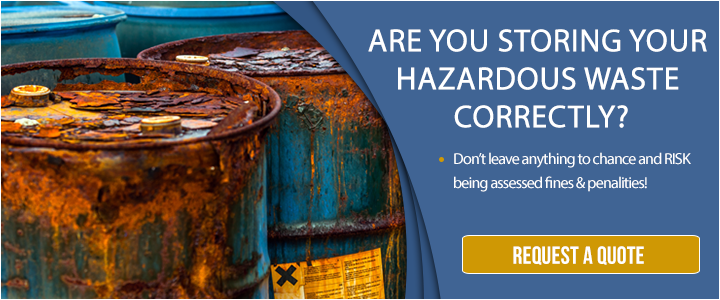Updated November 2025
Storing and handling chemicals responsibly isn’t just good housekeeping — it’s critical for employee safety, regulatory compliance, and environmental protection. Below are the updated Top 10 best practices for proper chemical storage, aligned with Cal/OSHA and EPA guidance and linked to deeper IDR Environmental resources.
1) Separate Incompatible Chemicals
Chemical segregation is foundational. Never store acids with bases, oxidizers with organics, or flammables with oxidizers. Separate acids from cyanides or sulfides to avoid toxic gas formation. Use compatibility groupings, place liquid containers in secondary containment, and maintain a digital chemical inventory that flags conflicts automatically.
California reference: Cal/OSHA Hazard Communication
2) Use Proper Chemical Storage Cabinets
- Store flammable liquids in NFPA 30–compliant chemical storage cabinets rated for seismic stability.
- Use corrosion-resistant polyethylene or epoxy-lined cabinets for acids and corrosives.
- Label chemical storage cabinets clearly with hazard class and “Keep Closed” signage.
- Locate cabinets in cool, ventilated areas away from ignition sources.
California reference: Title 8 §5533
3) Choose the Right Containers for the Job
Container compatibility matters as much as shelf placement. Use materials rated for the substance (glass, HDPE, or metal as appropriate) and meet DOT/OSHA specs. Mark the date received and date opened, inspect for rust, cracks, or swelling, and use our hazardous waste container inspection checklist monthly.
Federal reference: EPA: Hazardous Waste Management
4) Never Store Chemicals on the Floor
- Elevate all containers on corrosion-resistant shelving or spill pallets.
- Maintain a 6-inch clearance from floors and drains; keep aisles clear.
- Stage spill-response kits within easy reach.
5) Avoid Storing Chemicals Above Eye Level
Prevent drops and injuries by keeping heavy corrosives and flammables on lower shelves. Don’t store reactive materials above shoulder height; leave at least 18 inches below sprinklers/ceilings. For handling and usage pitfalls, see Avoid These Mistakes When Using Industrial Cleaning Chemicals.
6) Secure Shelving to Walls and Floors
In California, seismic anchoring is essential. Anchor racks, use anti-tip brackets, add anti-roll lips, and check fasteners during your monthly facility safety inspection.
California reference: Cal OES: Seismic Safety
7) Add Anti-Roll Lips and Secondary Containment
- Equip shelves with a 1-inch edge or roll-off guards.
- Use spill trays sized to at least 110% of the largest container.
- Verify containment materials are compatible with stored chemicals.
8) Label Everything Completely and Clearly
Apply GHS-compliant labels with full chemical name (no abbreviations), concentration, hazard pictograms, and dates. Consider QR codes that link to digital SDS. Cross-check labels against your chemical inventory system during audits.
California reference: DTSC: Hazardous Waste Management
9) Dispose of Expired or Unknown Chemicals
Outdated materials can become unstable or reactive. Conduct quarterly expiration checks, tag degraded containers, and remove them via lab-pack. Learn how in Clear Out Your Expired Chemicals With Lab Pack Services.
10) Inspect Regularly and Keep Accurate Records
- Verify labels, storage conditions, and spill controls monthly.
- Check shelving stability, cabinet doors, and ventilation.
- Confirm eyewash/shower service and fire extinguisher readiness.
- Document findings in your hazardous waste inspection log for compliance.
California reference: Cal/OSHA Title 8 §5194 – Hazard Communication
Why Proper Chemical Storage Matters
When hazardous chemical storage is neglected, even small leaks or mix-ups can lead to injuries, fines, and costly cleanup. Implementing these measures — from chemical compatibility and flammable liquid storage to secondary containment, chemical labeling, and routine inspections — protects people, property, and the environment.
Related Reading from IDR Environmental
- What to Look for When Purchasing a Chemical Storage Cabinet
- Clear Out Your Expired Chemicals With Lab Pack Services
- Hazardous Waste Segregation Guide
- How to Create a Chemical Inventory for Your Business
- Secondary Containment Requirements for Hazardous Waste
- Hazardous Waste Container Inspection Checklist
- Hazardous Waste Inspection Checklist
- Avoid These Mistakes When Using Industrial Cleaning Chemicals
Need Help With Chemical Storage or Disposal?
IDR Environmental helps California facilities create compliant chemical storage programs, perform lab packs, and manage hazardous waste safely.


Comment